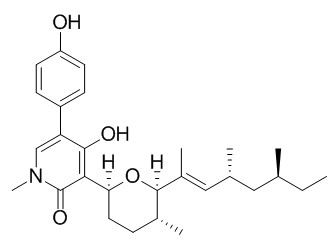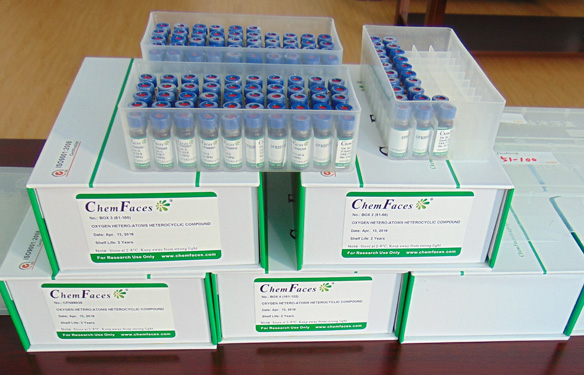Sambutoxin
Sambutoxin, a new mycotoxin produced by toxic Fusarium isolates obtained from rotted potato tubers, it can cause toxic effects in rats, including body weight loss, feed refusal, hemorrhage in the stomach and intestines, and, finally, death when rats were fed diets supplemented with 0.05 and 0.1% sambutoxin. Sambutoxin has in vitro cytotoxicity against various human and murine tumor cells and values of sambutoxin ranged from 46.2 to 1,425.6 ng/ml. It inhibits rabbit platelet aggregation, which may be party due to the decrease of ATP release.
Inquire / Order:
manager@chemfaces.com
Technical Inquiries:
service@chemfaces.com
Tel:
+86-27-84237783
Fax:
+86-27-84254680
Address:
1 Building, No. 83, CheCheng Rd., Wuhan Economic and Technological Development Zone, Wuhan, Hubei 430056, PRC
Providing storage is as stated on the product vial and the vial is kept tightly sealed, the product can be stored for up to
24 months(2-8C).
Wherever possible, you should prepare and use solutions on the same day. However, if you need to make up stock solutions in advance, we recommend that you store the solution as aliquots in tightly sealed vials at -20C. Generally, these will be useable for up to two weeks. Before use, and prior to opening the vial we recommend that you allow your product to equilibrate to room temperature for at least 1 hour.
Need more advice on solubility, usage and handling? Please email to: service@chemfaces.com
The packaging of the product may have turned upside down during transportation, resulting in the natural compounds adhering to the neck or cap of the vial. take the vial out of its packaging and gently shake to let the compounds fall to the bottom of the vial. for liquid products, centrifuge at 200-500 RPM to gather the liquid at the bottom of the vial. try to avoid loss or contamination during handling.
J Ginseng Res.2023, 47(4):593-603.
ACS Nano.2018, 12(4):3385-3396
Kasetsart University2022, ethesis.1144.
Appl Biochem Biotechnol.2020, 190(2):732-744
Food Research International2016, 106-113
Plant Commun.2024, 5(10):101005.
Antioxidants.2022, 11(4), 67.
Environ Toxicol.2021, 36(9):1848-1856.
Asian Journal of Chemistry2014, 26(8):2425
Plant Direct.2021, 5(12):e372.
Related and Featured Products
Appl Environ Microbiol. 1995 Oct;61(10):3750-1.
Sambutoxin-producing isolates of fusarium species and occurrence of sambutoxin in rotten potato tubers.[Pubmed:
16535155]
A total of 50 Fusarium isolates representing 13 species from various sources were surveyed to determine their potential to produce Sambutoxin.
METHODS AND RESULTS:
Sambutoxin production was restricted to Fusarium sambucinum and F. oxysporum, with the exception of one isolate of F. semitectum. Sambutoxin was produced by high percentages of F. sambucinum (80.0%) and F. oxysporum (84.6%) isolates at levels of 1.1 to 101.0 (mu)g/g. In addition, 9 (42.9%) of 21 rotten potato samples were contaminated with Sambutoxin at levels of 15.8 to 78.1 ng/g.
Agric. Chem. Biotechnol.,1988,41(4):273-4.
In vitro Cytotoxicity of Sambutoxin.[Reference:
WebLink]
METHODS AND RESULTS:
In vitro cytotoxicity of Sambutoxin was measured by using various human and murine tumor cells and values of Sambutoxin ranged from 46.2 to 1,425.6 ng/ml.
Appl Environ Microbiol. 1994 Dec;60(12):4380-6.
Sambutoxin, a new mycotoxin produced by toxic Fusarium isolates obtained from rotted potato tubers.[Pubmed:
7811078]
Ninety-nine isolates of Fusarium species were obtained from rotted potato tubers from various parts of Korea.
METHODS AND RESULTS:
Of these isolates, 80 were identified as Fusarium oxysporum, F. solani, or F. sambucinum. The isolates of these species were grown on autoclaved wheat grains and examined for toxicity in a rat-feeding test. A total of 8 of 57 F. oxysporum isolates, 3 of 14 F. solani isolates, and 5 of 9 F. sambucinum isolates caused the death of the rats. Of the 16 toxic isolates, 1 isolate of F. oxysporum produced a substantial amount of moniliformin, which could account for its toxicity. None of the other 15 isolates produced trichothecenes, moniliformin, fusarochromanone, fumonisin B1, or wortmannin. F. sambucinum PZF-4 produced an unknown toxin in wheat culture. This new toxin, given the trivial name Sambutoxin, caused toxic effects in rats, including body weight loss, feed refusal, hemorrhage in the stomach and intestines, and, finally, death when rats were fed diets supplemented with 0.05 and 0.1% Sambutoxin. The toxin was also toxic to chicken embryos, and the 50% lethal concentration was 29.6 micrograms per egg. Sambutoxin formed as white crystals that turned purple when combined with reagents such as sulfuric acid and p-anisaldehyde. It exhibited a green color immediately after treatment with potassium ferricyanide-ferric chloride. Its UV spectrum had absorption maxima at 213, 233, and 254 nm, and its infrared spectrum showed an amide group at 1,650 and 1,560 cm-1 and a hydroxy group at 3,185 cm-1.
CONCLUSIONS:
Mass spectrometry showed that the molecular weight of the toxin was 453 and the molecular formula was C28H39NO4.
Toxicol.Res.,1998 ,14(4):333-9.
Effects of Sambutoxin on the Rabbit Platelet Aggregation[Reference:
WebLink]
Sambutoxin, a newly purified mycotoxin in Koea, caused hemorrhage in the stomach and intestine of rats. To elucidate the mechanism of hemorrhage, effects of Sambutoxin on rabbit platelet aggregation were investigated.
METHODS AND RESULTS:
First of all, the effects of Sambutoxin on the platelet aggregation response and ATP release from platelet by various appregating factors were investigated. And then the role of on the platelet aggregation was investigated by flow cytometer. Finally, morphological effect of Sambutoxin on platelet ultrastructure was examined by transmission electron microscope. Sambutoxin inhibited aggregation induced by ADP, collagen, thrombin, and arachidonic acid and decreased platelet activating factor-induced disaggregation time in a dose dependent manner. Sambutoxin also decreased thrombin and arachidonic acid-induced ATP release, but increased all factors induced release. Sambutoxin showed severe ultrastructural changes of platelet such as appearance of disorganization debri of cellular organelle in intercellular space.
CONCLUSIONS:
Our results indicate that Sambutoxin inhibitis rabbit platelet aggregation, and it may be party due to the decrease of ATP release. However, it is not clear whether the antiaggregating effect of Sambutoxin is related to increase.



